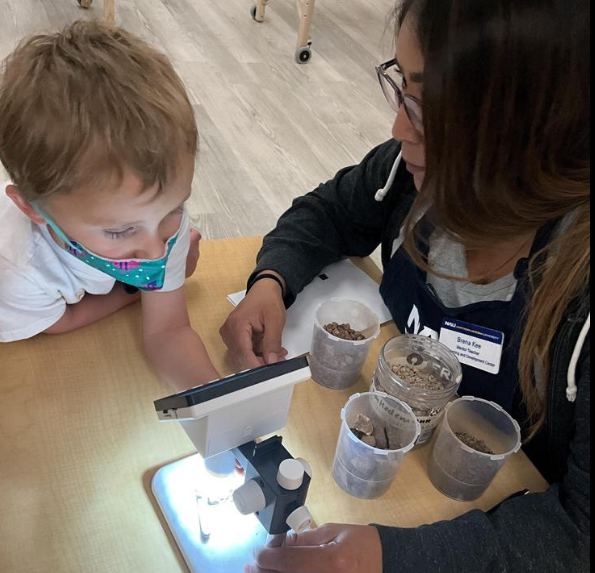
Sensory experiences provides space for using all five senses in the classroom. Children explored the function of sand and how it serves environments.
Phase 1: Children’s interest in the sand Accordion Closed
Our staff observed that children were very interested in our sand and sensory table. Each day, all of the children would spend some time at the table, exploring different tools and props to use in the sand table.
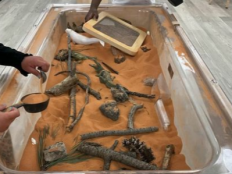
Why were children interested in the sand table? What more might they want to learn about sand?
Our teachers webbed potential topics for what children might want to know about sand, and what materials and experiences we could provide to support their learning.
Children shared what they already knew about sand, picking specific ideas they wanted to share.
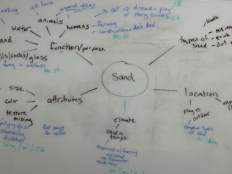
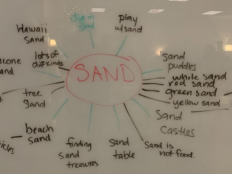
Phase 2: Investigating sand Accordion Closed
Where does sand come from?
Teachers started by making sure children had common experiences and vocabulary to use related to sand. We asked children where sand came from. Children collected samples of sand from our playground and outside of the duck pond behind the school. Children labeled and discussed the difference between a rock, pebble, and a grain.
Children documented what they thought sand looked like, and labeled their drawings.
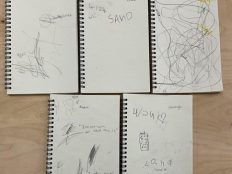
Leora looked at the differences between a rock, pebbles, and sand grains. We began with a ruler to divide the index card into three sections. Next, we wrote the word, Rock and draw a corresponding picture. Next, we wrote pebbles and drew pebbles. Finally, we looked at all the tiny sand grains, labeled and wrote them on to the last section. Leora wrote each word out on her own with letters names being said by the teacher. Leora also used an arrow to show her grain of sand.
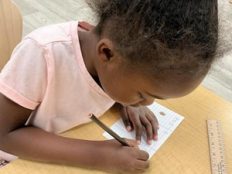
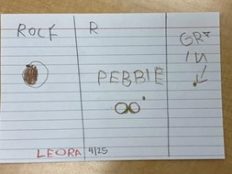
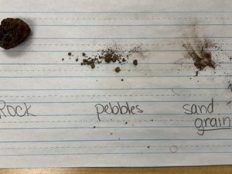
Children were asked to bring sand samples from home to share with the class. They were asked where they got their sand and to describe it.
Ami: At the beach!” -Ami
**Amanita’s sand was labeled from Tempe Lake – We looked online to help describe where Tempe is located.
Next, we set out sand samples on white paper. Students were able to touch, feel and then asked to describe the sand they were touching.
Brena: How does your rock feel?
Austin: Soft.
Julius: Big.
Leora: Small.
Austin: This one is dirt.
Next, we talked about dirt and the differences.
Brena: What is dirt?
Leora: From the ground.
Brena: What about sand?
Leora: From the beach.
Students were differentiating the differences by pointing out that sand comes from the beach while dirt can be found on the ground.
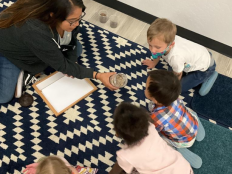
They were asked to describe the texture, the color and size. Next, we counted our 5 rocks, placed them into the mason jar and noted that there were only rocks in the jar. The next step was to close the lid and shake the jar with the rocks inside. Students took the lid off of the jar, looked inside and many said, “sand” as we poured the contents out on the tray.
Julius: Three, four, five!
B: What are these?
Julius: Rocks.
B: What color is this rock?
Julius: Black.
Julius: Brown.
B: This rock is pointy.
Julius: Pointy.
Julius: I see holes in rock.
B: Do you see any sand in there?
Julius: I see rocks.
Julius shaking jar.
B: Look at mine *dust coming out of jar
Julius: Oh! Oooh! Whoa!
B: What do you see?
Julius: *continues shaking, opens lid* Oh! Oh! *Squints and blows at his jar*
B: Pour your rocks out on the tray, Julius.
Julius: *Pours out contents, moves finger through sand* Look! It’s sand table!
B: What did you make?
Julius: That’s sand table. More break.
B: Are you going to break more rocks?
Julius: All done.
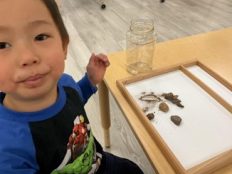
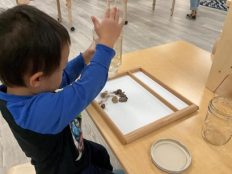
Types of sand Accordion Closed
We examined the sand in our classroom environment: sandbox sand, tan kinetic sand, and outdoor sand. Students discussed sand textures, colors, similarities and differences between them all. They examined grains with a microscope.
Red sand table sand
H: This sand is soft.
A: It’s dry.
Tan kinetic sand
L: You can squish this sand together.
A: If you squeeze it, it’ll do this (holds out hand to show sand molded to hands.)
H: It smells funny.
A: it’s so soft.
Tan jurassic sand
A: I feel hardness in this sand.
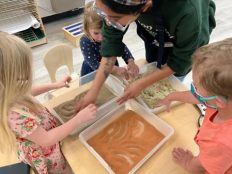
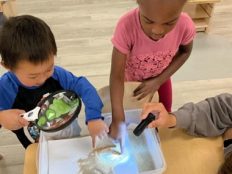
The teachers integrated different materials into the sand.
The students explored sand with the light table. Dry sand was poured on to the light table and the students explored with texture, grain sizes and colors. They also changed the colors on the table to bring out various colors of sand and they inspected with magnifying glasses.
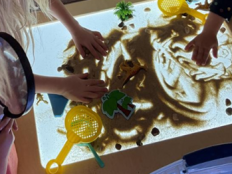
C: What color do you see?
H: Gray.
A: Brown
L: Let’s turn the light table blue.
J: Blue!
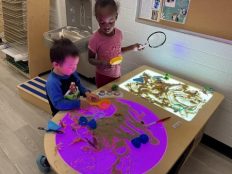
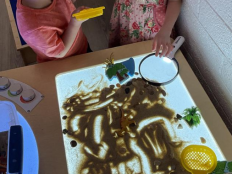
Microscope observation:
Children were asked to bring sand samples from home to share with the class. They were asked where they got their sand and to describe it.
Ami: At the beach!” -Ami
**Amanita’s sand was labeled from Tempe Lake – We looked online to help describe where Tempe is located.
Next, we set out sand samples on white paper. Students were able to touch, feel and then asked to describe the sand they were touching.
Brena: How does your rock feel?
Austin: Soft.
Julius: Big.
Leora: Small.
Austin: This one is dirt.
Next, we talked about dirt and the differences.
Brena: What is dirt?
Leora: From the ground.
Brena: What about sand?
Leora: From the beach.
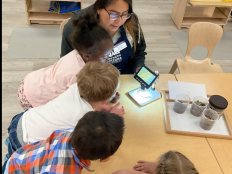
Students were differentiating the differences by pointing out that sand comes from the beach while dirt can be found on the ground..
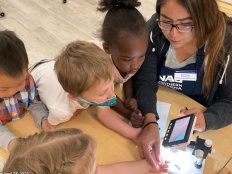
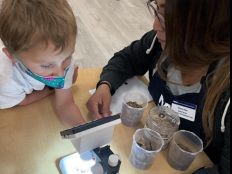
Water and sand Accordion Closed
Students studied an introductory lesson to erosion through sand and the effects of water. First, we created a pathway for the water to flow by creating sand banks to create a stream. Next, we poured water down the stream which resulted in the sand shifting the banks and grains covering the surface of the tray. Next, students used spray bottles to spray water with the jet and misting settings. Finally, students came in and used the construction vehicles to create openings to divert the water.
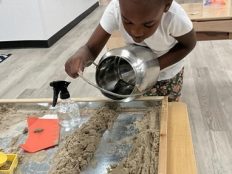
Children then experimented with ice and mud in our sensory tables.
C: What’s happening?
O: They’re turning to mud.
B: What are the ways we move sand?”
Ami: Sand.
Austin: It’s cold.
B: What is it?
A: It’s an ice cube!
B: Once the ice gets warm enough it’s going to melt.
B: What is it called when wind breaks sand down?
H Erosion.
C: You can drag the sand.
Austin: I don’t want to.
C: Okay you don’t have to.
A: It’s making tracks.
C: It is making tracks.
Julius: It’s so cold.
C: What do you like playing with the most?
Leora: Wet sand.
C: What do you feel, Julius?
Julius: Cold.
C: Is it squishy?
J: Squish.
C: Can we eat this?
Leora: No, no.
C: No, why can’t we eat it Leora?
L: Yucky.
Erosion Accordion Closed
Our new vocabulary words this week is erosion. What is it? Earth materials that are moved around by natural forces such as wind and water.
We presented pictures and videos to help children understand what erosion looks like. We discussed about the rocks in the beach and where they might go. We observed waves crashing into the shore and noticed how sand moves when the waves pull back into the ocean.
We have seen how erosion works in the real world. To further deepen our understanding of erosion, children conducted experiments to represent what it would look like in our classroom.
We broke down rocks (cookies) into grains and utilized elements such as wind and water to witness how the grains move around.
In our other experiment, children combined rocks (starburst) to represent how small grains combine with other grains to give us different shapes, color, and weighted rocks.
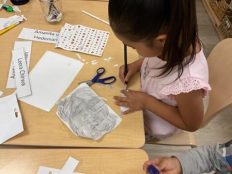
Olivia worked on shading her picture after she was dropped off today. She worked about 20 minutes before Ms. Brena asked what she was working.
B: Wow, Olivia. That looks great. What did you draw?
Olivia: This is a mountain. It’s erosion!
Olivia: The rocks are breaking.
What animals live in the sand Accordion Closed
During our morning meet, we had a special guest come and talk to us about animals that burrow in the sand. As part of our sand exploration, we recalled the animals we learned about; tortoise, kangaroo mouse, a lizard, and a fox. Next, we looked our photos and defined what it meant to burrow. Many students connected burrowing with animals that dig holes and tunnels in the ground. They drew a photo of a tortoise that is sitting in their burrow.
Julius wrote the word, Burrow on the top of his page from left to right. Next, he drew a circle to indicate the burrow and then drew a turtle inside the burrow.
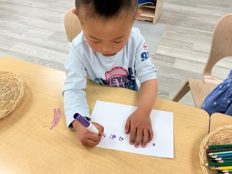
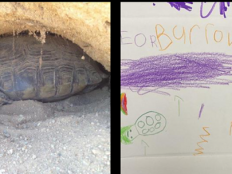
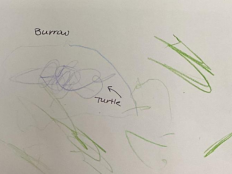
Our first visitor came and helped deepen children’s understanding about sand and how it is used in the real world. Mr. Adam, Amanita’s dad, works in making sure that any construction plans do not harm or interfere the wildlife in the area. He brought in pictures to share and told us about the animals he has worked closely with. Prior to our first visitor, children learned about tortoises and their lifestyle.
Adam: In the desert a lot of things dig in the sand. Is it easier to dig in the sand or in a rock?
Austin: Sand.
*Mr. Adam points to the different drawn burrows.*
Adam: Sometimes you can tell what made a hole. It depends on what animal made the burrow. What burrow did the fox make?
B: What’s the fox standing in?
Children: Sand.
B: What are the little lines running down?
Austin: Cracks.
Brena: You see the white roots, that is what’s lining this area right here.
Lily: They’re going to get so huge.
C: Do you think they are going to grow too big?
Lily: Yeah!
Adam Is the rat standing on all 4 feet?
Austin: No.
Adam: No, he’s standing like a kangaroo.
Adam: Turtles in the desert are called tortoises and they don’t need water to live.
Olivia: Baby tortoise!
Andres: Baby tortoise!
C: Do they eat rocks? (Tortoise)
Adam: Yes they eat rocks.
Olivia: Turtles eat kale.
Adam: Yes they eat kale and vegetables. Tortoises eat dirt too for minerals.
Austin: I saw a big bug yesterday that was right next to the sand.
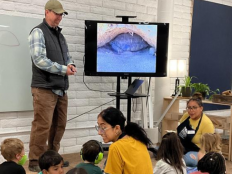
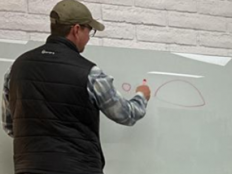
Phase 3: Showing our learning Accordion Closed
Children and teachers decided to host a sand showcase for the families at the end of the project. Teachers asked children about the activities they remembered, and recreated the activities in the classroom for children and families to reenact together.
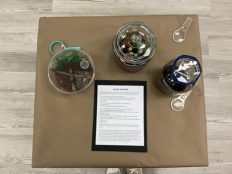
Children shared artifacts from the sand project, including drawings and notes about their learning.
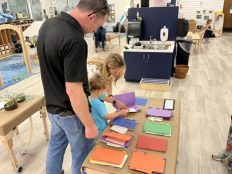
Children demonstrated how to make sand.
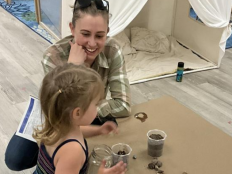
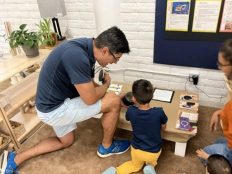
Teachers helped children act out the story A Line in the Sand. The children acted out the animals and demonstrated where they were positioned in the sand.
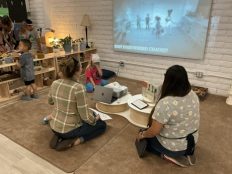
Watch our short movie: